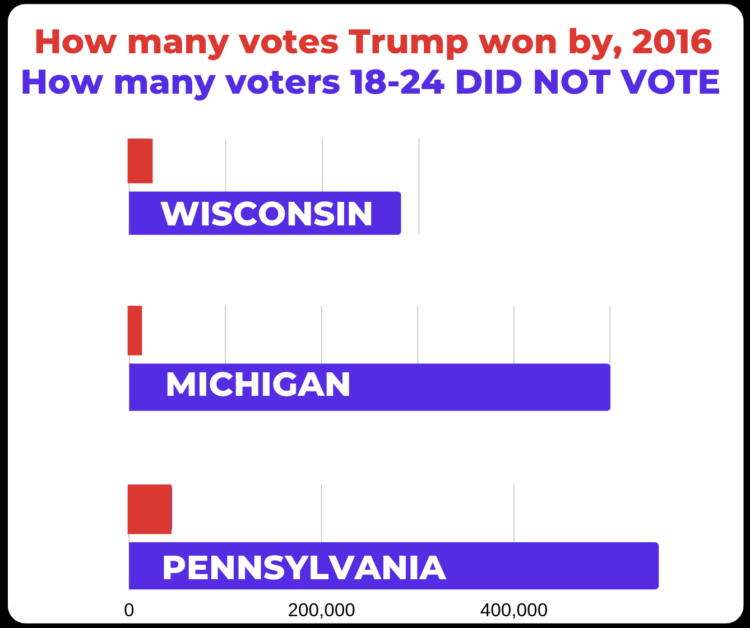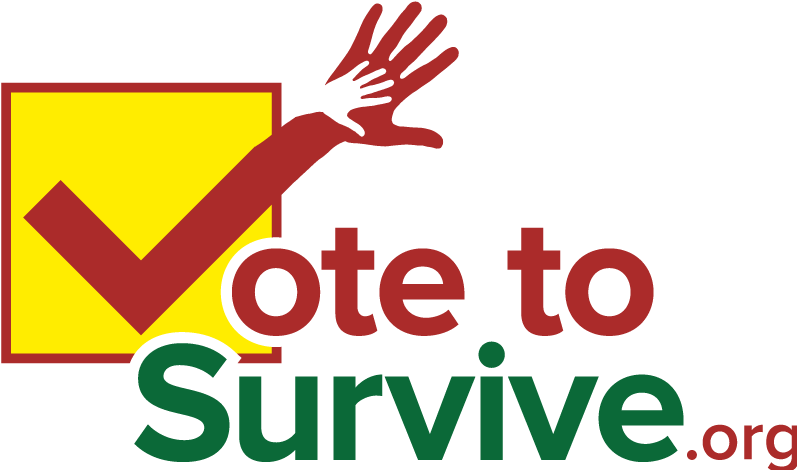In 2016, Hillary Clinton got nearly 3 million more votes nationwide than Donald Trump. But Trump won the electoral college vote by narrowly winning in just three states: Michigan, Wisconsin and Pennsylvania.
In Michigan, Trump beat Clinton by just 10,704 votes, thus capturing all 16 of Michigan’s electoral college votes. More than 500,000 young people under 25 did not vote in that state. Just a tiny fraction of that number could have changed the final outcome in that state.
In Wisconsin, where Trump won by 22,748 votes (and gained another 10 electoral college votes), there were 281,000 young people who could have voted but did not. And in Pennsylvania, where Trump won by 44,292 votes, taking him over the top in the electoral college and winning him the election, almost 550,000 more young people could have voted.

In a total of 10 states that Trump won in 2016, the number of potential voters under 25 who did not vote was easily larger than the Trump’s margin of victory over Hillary Clinton in those states. Even in Texas, where Trump got 807,000 more votes than Clinton, the number of young people who did not vote in that state was vastly larger: in the case of Texas, nearly 1.5 million young people did not cast their ballot.
Altogether, 15 million eligible voters under the age of 25 did not vote in the last Presidential election. Another 16.5 million potential voters have turned 18 since that election and are thus eligible to vote in this Presidential election for the first time.
None of that is to say that young people are to blame for giving us Trump in 2016. That honor most definitely goes to the older generations, who voted much more decisively for Trump than did the young people who did vote in that election. Nor can we assume that if more young people voted in 2016, they would have necessarily voted for Hillary Clinton. Indeed, one of the main reasons given by young people for not voting is that they felt let down by both of the main political parties and didn’t like the idea of voting for either of them.
That could be a reason for many young people not voting again this time around. Except that this time our survival really is at stake. This time, it’s not just climate change that threatens the future of all young people. And it’s not just the possibility of nuclear war, or the continuing collapse of our economy because of COVID-19.
Under Donald Trump, this country has taken so many backwards steps on so many fronts it is difficult to decide which are the most serious. Should we be worrying more about the rise of white supremacist militias storming state houses and trying to kidnap governors, or should we be worrying about the real and growing threats to our democracy itself, with a President who won’t even commit himself to abiding by the results of the election?
Joe Biden is not the candidate of choice for most young people in this country. He’s about 40 years too old for a start. And maybe his heart is in the right place, but he seriously doesn’t get it. He just wants to go back to the “good old days” before Trump. And that’s not enough to save us or our country or our planet. We need a serious overhaul of our entire system, and all Joe Biden wants to give us is a bit of tinkering around the edges.
But with 15 million young people who didn’t vote last time, and another 16.5 million young people able to vote for President for the first time, that’s almost half the total number of votes Trump got from the entire country in 2016. Think what that could mean, if even a fraction of that number decided to rise up and be heard at this election.
In 2028, AOC and others of her generation will be old enough to run for President. And that’s when this country is really going to start rocking. But to reach that day, we first have to survive. And that means getting out the youth vote for Joe Biden, overturning the mess of the last four years, and paving the way for real change in the years to come.

